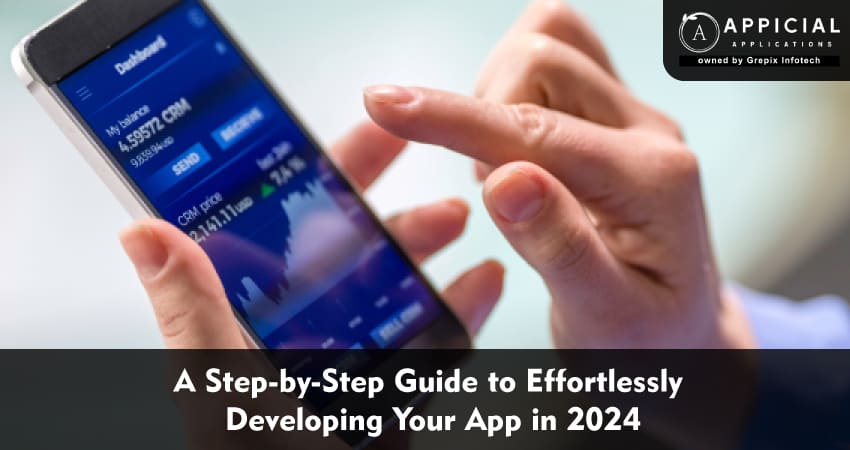
A Step-by-Step Guide to Effortlessly Developing Your App in 2024
Not long ago, businesses typically outsourced mobile app development, mainly due to budget constraints and prolonged development cycles. Yet, the landscape has shifted. Thanks to accessible development platforms and software tools that handle a significant portion of the preliminary work, an increasing number of small businesses are now taking app development into their own hands.
This change has led to a growing recognition of the value of mobile app development, whether for internal operations or for customer engagement. Embarking on the app development journey, especially for the first time, might seem overwhelming, but it promises to be a fulfilling endeavor. This comprehensive guide is designed to walk you through the entire development of an app lifecycle, empowering you to create a successful app.
Crafting a successful app in today's competitive digital landscape requires a blend of innovation, strategic planning, and meticulous execution. As a leading taxi app development company, we've navigated the intricacies of app creation from ideation to launch.
Here's our distilled wisdom on developing an app in easy steps, tailored for 2024 and beyond. This guide serves as a blueprint for entrepreneurs and businesses aiming to make a mark in the taxi industry or any other mobile app domain.
This comprehensive guide outlines a step-by-step approach for small businesses venturing into app development in 2024, highlighting the shift towards in-house development due to accessible platforms and tools. It covers essential steps from ideation and market research to define your app's value proposition, sketching ideas, selecting the right technology stack, and developing a Minimum Viable Product (MVP). The guide emphasizes the importance of rigorous testing, a strategic launch coupled with App Store Optimization (ASO), collecting user feedback for iteration, regular updates, and effective marketing. Aimed at entrepreneurs and businesses targeting the taxi industry or other mobile app domains, it serves as a blueprint for creating a successful app by blending innovation with strategic execution.
1. Ideation and Market Research
Ideation and Market Research stand as the foundational pillars in the journey of mobile app development, embodying the fusion of creative brainstorming and analytical rigor. This phase is pivotal in identifying a gap in the market or a specific user need that your app can address. It involves a deep dive into understanding your target audience, their preferences, pain points, and behaviors, as well as analyzing the competitive landscape to pinpoint opportunities for differentiation. Through ideation, you cultivate a myriad of ideas, filtering them down to those with the potential for real impact. Market research then validates these ideas, ensuring they are grounded in actual user demands and market trends. This dual process not only sharpens the focus of your app concept but also lays a solid foundation for its successful development and launch.
2. Define Your App's Value Proposition
Defining your app's value proposition is a crucial step in the app development process, as it clarifies why users should choose your app over others. It's the unique promise of value to be delivered—a clear statement that explains how your app solves users’ problems, offers specific benefits, and tells the user why this app is better than the competitors. A compelling value proposition focuses on the key features that differentiate your app, whether it’s an innovative way of connecting people, a unique feature set, an exceptional user experience, or cost-effectiveness. It should be succinct, explaining in simple terms what makes your app valuable to potential users. Getting this step right helps guide the development process, informs marketing strategies, and significantly increases the likelihood of your app's success by resonating with your target audience and meeting their needs or desires in a way that no other app does.
3. Sketch Your Ideas
Sketching your ideas is an integral step in the app development process, serving as a bridge between your initial concept and the digital creation to come. This stage allows you to visualize the user experience (UX) and interface (UI) in the most tangible form. By putting pen to paper, you can experiment with the layout of screens, the placement of buttons, and the flow from one section of the app to another, all without the need for technical skills or software.
This manual process encourages creativity and spontaneity, making it easier to explore various design options and iterations quickly. Sketching is not about creating perfect illustrations but about translating your vision into visual concepts that can be easily understood and shared with others. It's a collaborative tool that helps communicate your ideas to team members, stakeholders, or developers, ensuring everyone has a clear understanding of the app's intended design and functionality. Sketching your ideas early on can save time and resources by identifying potential usability issues or design improvements before any code is written, setting a strong foundation for the development process.
4. Select the Right Technology Stack
Selecting the right technology stack for your project is crucial as it lays the foundation upon which your application's performance, scalability, and maintenance will depend. A well-chosen stack ensures that your app can handle growth, integrate seamlessly with other services, and provide a robust user experience. Factors to consider include the project’s requirements, the team's expertise, and the technology's community support. For instance, a complex, data-driven web application might benefit from a combination of React for the frontend and Node.js for the backend, supported by a MongoDB database. This combination offers scalability, ease of development, and a large pool of resources and libraries. Moreover, considering future trends and potential integrations can safeguard your app against becoming obsolete, making your technology stack choice a pivotal decision in your project's lifecycle.
5. Develop a Minimum Viable Product (MVP)
Developing a Minimum Viable Product (MVP) is a strategic approach that focuses on launching an application with enough features to attract early adopters, yet minimal enough to minimize costs and time spent in development. This methodology allows you to test your app's core hypothesis with real users and gather valuable feedback for iterative development. By prioritizing functionality that addresses the primary need of your target audience, you can ensure your app enters the market swiftly, providing insights into user preferences and behavior. An MVP not only validates your app concept but also establishes a foundation for future enhancements based on actual user data. This lean startup approach reduces risks, conserves resources, and paves the way for a product that truly resonates with its intended user base, making it an essential step in the journey of app development.
6. Test Rigorously
Rigorous testing is an indispensable phase in the development process, ensuring the reliability, security, and usability of the final product. This phase goes beyond merely identifying bugs in the code; it's about scrutinizing every aspect of the application under various conditions to guarantee a seamless user experience. Effective testing involves a combination of automated tests, which can quickly cover a wide range of scenarios, and manual testing, which brings a human perspective to the user experience. Techniques such as unit testing, integration testing, system testing, and acceptance testing are employed to evaluate different facets of the software. Furthermore, stress and performance testing are critical to understanding how the application behaves under peak loads.
7. Launch Strategy and App Store Optimization (ASO)
Crafting a meticulous launch strategy paired with a robust App Store Optimization (ASO) plan is paramount for the success of any mobile app. This dual approach begins with a comprehensive understanding of your target audience and a strategic marketing campaign to generate buzz. Utilizing ASO techniques ensures your app stands out in a crowded marketplace, focusing on optimizing key elements like the app's title, keywords, description, and visuals to enhance its visibility and appeal. Encouraging early users to leave positive reviews and ratings further propels your app's credibility and search rankings. Continuously analyzing performance metrics post-launch allows for iterative improvements, ensuring your app not only captures but also retains user interest. This careful blend of launch strategy and ASO maximizes your app’s potential for success, making it discoverable, desirable, and downloadable.
8. Collect User Feedback and Iterate
The cycle of collecting user feedback and iterating based on this input is crucial for the continuous improvement and success of any application. This iterative process begins by engaging with users through surveys, in-app feedback tools, social media, and review analyses to gain insights into their experiences, needs, and frustrations. By meticulously analyzing this feedback, developers and product teams can identify areas for enhancement, prioritize features that align with user demands, and address any usability issues. This approach not only ensures the product evolves in harmony with user expectations but also fosters a positive relationship with the user base, demonstrating that their opinions are valued and taken into account. Iteration based on user feedback is a dynamic strategy that encourages ongoing engagement, increases user satisfaction, and ultimately drives the app's growth and adaptation in a competitive market landscape.
9. Update Regularly
Keep your app up-to-date with the latest technology trends, security patches, and features. Regular updates not only improve functionality but also signal to users that you’re committed to providing a high-quality experience. This practice is pivotal not just for fixing bugs and closing security gaps, but also for adapting to user feedback, introducing new features, and staying compliant with the latest operating system standards and hardware advancements.
10. Market Your App
Marketing your app effectively is essential to cut through the noise in the saturated app market. A successful strategy involves identifying your target audience and tailoring your message to resonate with their needs and interests. Utilizing a mix of digital marketing tactics, including search engine optimization (SEO), social media campaigns, influencer partnerships, and paid advertising, can significantly increase your app's visibility. Engaging content that highlights your app’s unique features and benefits, coupled with compelling calls to action, can drive downloads and user engagement. Leveraging app store optimization (ASO) techniques ensures your app stands out in search results.
Conclusion
In conclusion, the journey to developing a standout taxi app in 2024 may seem daunting, but by following our step-by-step guide, you can navigate the process with clarity and confidence. From laying the groundwork with a solid strategy and choosing the right technology stack, to launching with a meticulously planned strategy complemented by effective App Store Optimization (ASO), every step is crucial for success.
Remember, the development of your app is only the beginning. Engaging with your users, iterating based on feedback, and keeping your app updated are ongoing tasks that ensure your app remains relevant and competitive. Marketing your app effectively will help it reach its intended audience and achieve your business goals.
As a taxi app development company, we understand the unique challenges and opportunities within this dynamic market. By staying committed to providing exceptional value and convenience to your users, your taxi app can not only thrive but also redefine the way people experience urban mobility in 2024 and beyond. Let's embark on this exciting journey together, transforming your vision into a reality that drives forward not just your business, but also the future of urban transportation.





